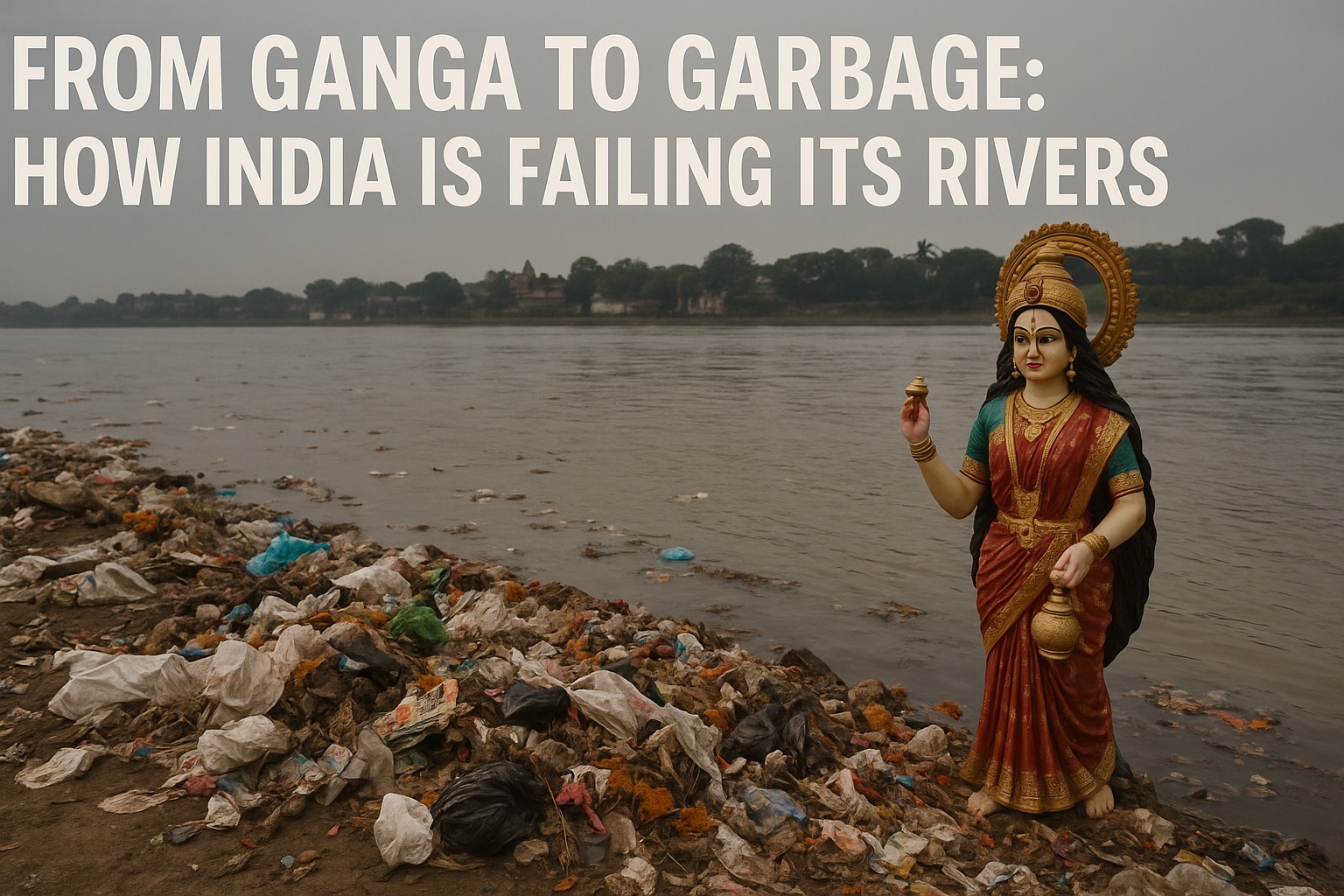Don't miss this exciting offer — contact us today and make it yours!

India’s rivers have long been the cradle of its civilizations. From the sacred Ganga and Yamuna in the north to the life-giving Godavari, Krishna, and Cauvery in the south, these water bodies are not just sources of water — they are carriers of culture, religion, agriculture, and industry.
But today, many of these rivers are choked, polluted, and dying. Despite billion-dollar missions and judicial interventions, India’s rivers are drowning in urban sewage, industrial waste, encroachment, and apathy.
This case study explores how India is systematically failing its rivers, what the root causes are, and what can still be done to prevent a full-blown ecological collapse.
The Ganga River, revered as a goddess by millions, is ironically also one of the most polluted rivers in the world.
Over 3,000 million liters/day of untreated sewage is dumped into it.
More than 700 industrial units discharge toxic waste along its banks.
Despite the Namami Gange Mission (₹30,000+ crore sanctioned), major cities like Varanasi, Kanpur, and Patna still release waste directly into the river.
India’s cities generate over 72,000 MLD (million liters/day) of sewage, but only 37% of it is treated. The rest finds its way into rivers.
Cities like Delhi, Kanpur, and Hyderabad are overburdened and under-equipped, with aging STPs (Sewage Treatment Plants) and poor last-mile connectivity.
Industries along riverbanks — tanneries, textiles, chemicals — often dump effluents directly into rivers.
Example:
The Yamuna in Delhi turns black and foamy during summers.
In Gujarat, the Sabarmati becomes toxic near Ahmedabad due to dye and chemical discharge.
Ironically, acts of devotion contribute to destruction:
Immersion of idols and religious waste
Cremation rituals along rivers
Mass bathing events during Kumbh Mela without sanitation support
Illegal sand mining in rivers like Yamuna, Ganga, and Son leads to:
Lower water tables
Disrupted aquatic ecosystems
Riverbank erosion and floods
Encroachment reduces river width, turning them into drain-like channels during dry seasons.
Catchment areas are being destroyed due to urbanization and forest loss.
Result: reduced percolation, dried tributaries, and erratic river flows.
Example: The Godavari dries up in summer across parts of Maharashtra and Telangana.
Yamuna in Delhi: Despite thousands of crores spent, the river is often compared to a “black drain”.
Only 2% of Yamuna’s length in Delhi carries 76% of its pollution load.
Sabarmati in Ahmedabad: The Sabarmati Riverfront Project is often praised as a success, but critics argue it beautifies the surface while ignoring deep pollution issues.
Launched in 2014 with huge ambition
Successes include afforestation, ghat beautification, STP upgrades
But on-ground pollution levels remain high, especially in UP and Bihar
Targets multiple rivers but lacks coordination with urban planning departments
Insufficient local governance and weak monitoring mechanisms
Courts have intervened — especially the National Green Tribunal (NGT) — but enforcement remains weak.
Health Crises: Waterborne diseases, skin infections, and even cancer clusters near polluted rivers
Fishermen’s Livelihoods: Aquatic life in rivers like Yamuna and Damodar has declined drastically
Agricultural Collapse: Polluted river water affects soil health and crop yields
Tourism Loss: Sacred cities like Varanasi, Rishikesh, and Haridwar lose appeal during peak pollution seasons
Empower cities and panchayats to build micro-STPs and waste segregation systems
Promote greywater reuse and biological treatment systems
Enforce real-time effluent tracking with automatic fines
Incentivize green manufacturing zones
Move beyond surface beautification to catchment-area restoration, flow management, and aquatic revival
Restore lost wetlands and tributaries
Run nationwide campaigns like “Swachh Nadi Abhiyan”
Promote religious reforms and eco-friendly rituals
Water, Urban Development, Environment, and Industry ministries must collaborate — not work in silos
Rivers need storytelling, not just schemes: The revival of the Thames and Rhine were driven by public emotion, media, and civic pride
Make rivers brandable causes for CSR, education, tourism, and clean-tech innovations
Startups in watertech, IoT, and sustainable rituals can drive both impact and growth
India’s rivers once nourished kingdoms, poetry, trade routes, and ecosystems. Today, they are on life support, waiting for intent, action, and unity.
The story of the Ganga — from worshipped waterway to a drain of national failure — is not just environmental. It’s deeply human, and deeply reversible.
If India wants to secure its future, saving its rivers must become a national obsession — not just a government program.